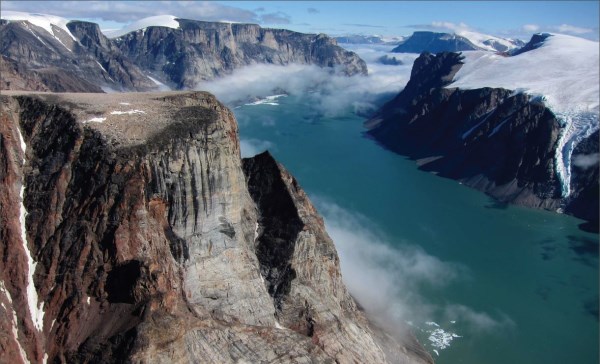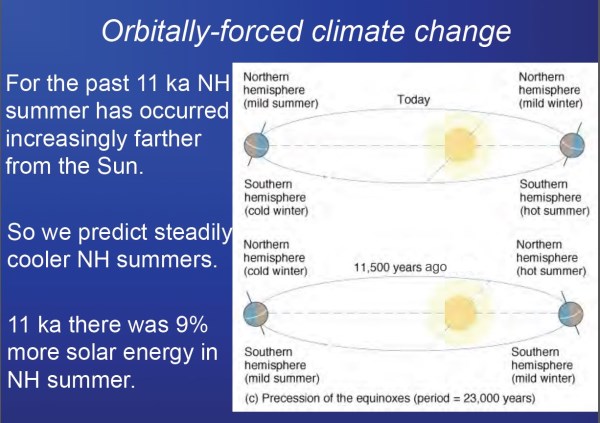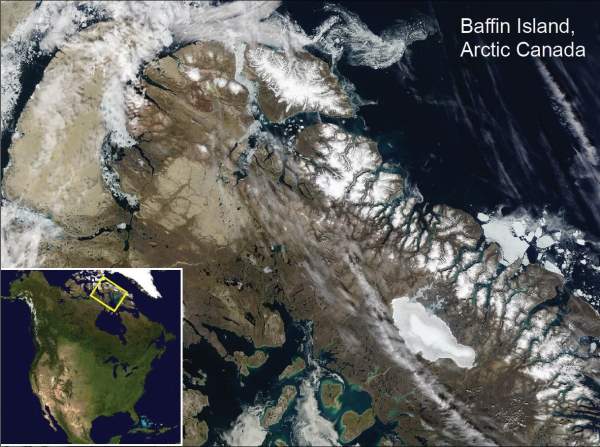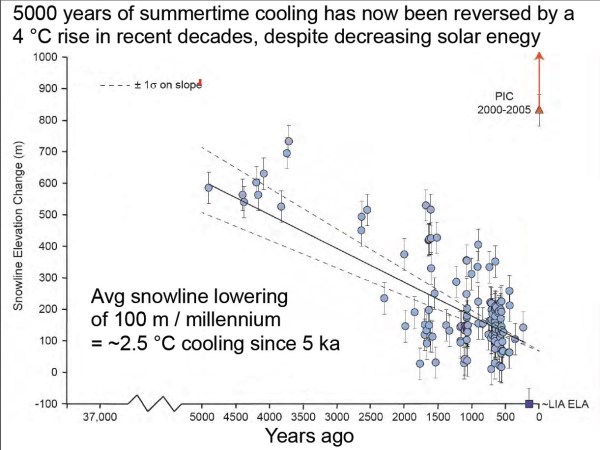At a PLAN-Boulder evening forum on Monday, January 27, Gifford Miller, a world-renowned geologist, described research about global warming that he and his team have recently conducted on Baffin Island and offered some observations about the likely effects of climate change on human populations.
Miller is a professor of geological sciences at CU and the acting director of the Institute of Arctic and Alpine Research (INSTAAR). He has published over 200 scientific papers in international, refereed journals.
Miller declared that the earth has been warming over the past several decades and the warming trend has been most pronounced in the arctic during summers. He said that summer temperatures had risen there by 4 degrees centigrade in the last 50 years. However, he noted that before this recent warming period the northern hemisphere had experienced a very long era of cooling. He said that summer temperatures had cooled 2.5 degrees centigrade over approximately 5,000 years before the last 50, and that 11,000 years ago the northern hemisphere had received 9 percent more solar energy in the summer than it does now. Glaciers started to grow 5,000 years ago, he asserted. He attributed the cooling phenomenon to natural variations in the earth’s orbit around the sun.
Miller stated that the last remnant of the North American ice sheet is located on Baffin Island, which he has been visiting for research purposes over the span of 45 years. His research was intended to determine whether there is a natural explanation for the recent arctic warming. Stated another way, he was trying to answer the question whether “unforced, multi-decadal cycles” explain the warming.
Miller and his team collected tiny, dead plants on the edges of 250 of Baffin Island’s ice caps, which are now receding at the rate of about half a meter a year. He said that because of wind and new precipitation these dead plants will disappear within a year after they emerge from the ice. His team had these plants radio-carbon dated and thereby determined that nine of them had been covered by ice at least 41,000 to 52,000 years ago. However, he noted that 52,000 years is as far back as the radio-carbon dating technique can reach. He speculated that some of the older plants on Baffin Island had been under ice for 120,000 years.
Miller asserted that there is no logical explanation for the warming phenomenon during the last 50 years other than changes in the composition of the gases in the atmosphere, and the overwhelming cause of changes in these gases is the carbon dioxide and other greenhouse gases created by human activity.
The summers in the arctic during the last 50 years have been warmer than at any time in at least the past 45,000 years, Miller concluded. He remarked that he had personally noticed effects of warming on Baffin Island. He said when he started to visit there lightning occurred very infrequently and the natives did not even have a word for thunder. He said that in recent summers thunder storms have been common events. He also said that the polar bears had become much more aggressive with humans than in the past, because they have lost access to seals, their traditional diet, for twice as long in summer, because sea ice melts earlier and reforms later now. He said that they were eating seaweed and raiding the camps of his teammates in search for food. He said he ordered one of those camps abandoned due to the bears’ incursions and had armed guards posted around other ones during the nights.
Miller announced that climate change will happen no matter what humans now do. He predicted that the “equilibrium state” after climate change will be “not too bad” for humans, because we are amazingly adaptable. He commented that the main danger to people will be the possible rate of change. If change occurs too fast, we will have trouble adapting. If New York City has to be moved inland in 20 years, he remarked, that transition might be impossible. But if it has to be moved in 200 years, that shift would probably be manageable.
The arctic will warm more than any other part of the earth, he claimed. There will be more rainfall around the world and also more evaporation. The balance of precipitation versus evaporation will change in most parts of the world.
He speculated that from decades to a century from now sea level will rise four meters. All of south Florida will be under water, as will parts of New York City and other coastal population centers. He declared that the majority of the world’s people live in a zone that will feel the impact of sea level rise. He noted that some nationalities, such as the Bangladeshis, will have to vacate large portions of their native lands and that in such instances violent conflicts may well arise with neighboring populations.
Miller expressed astonishment that the private sector has not been more active in planning for the impacts of climate change. He predicted that it will open huge opportunities for entrepreneurs. He said that the biggest reinsurance companies have been studying the likely effects of climate change. But he said not many other businesses appear to be paying attention to it.






